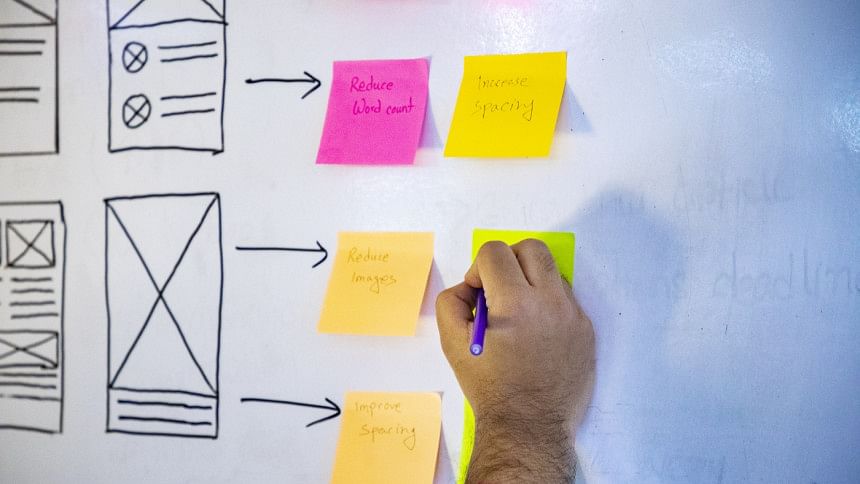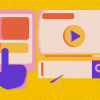Pursuing a career in UI and UX: What you should know

User interface (UI) and user experience (UX) are integral parts of the everyday applications and websites used globally, as they translate the core concept of a product into a functioning user-intuitive experience. Essentially, UI/UX designers are responsible for creating the look and feel of a website or application. As such, these designers are in expansive demand in the tech industry.
Though often interchangeably used, UI and UX are two different specialisations in the design process. Amit Mojumder, a product designer at Optimizely, described the differences saying, "While UI focuses on the visual and interactive elements of a product, UX encompasses the entire user journey, including emotions, thoughts, and perceptions. UI is a crucial component of UX, but it's just one piece of the puzzle. Companies often tend to use these terms together because they expect a single person will wear multiple hats as both a UI designer and a UX designer. It's a misconception that a designer has to be a UI/UX designer. You can only be a UI designer, whose job is to collaborate with the UX designer about the interaction decisions and create a simple, minimalist, and easy-to-understand interface that serves the business purpose. On the other hand, UX designers decide on how the presented screen will interact with another screen. For example, on a signup page, you see a button called "sign-up". What should happen if you click on sign-up is a UX decision. UX designers make that decision by researching, design validating with the user, and so on."
Fayek Al Rafi, a partner, co-founder, and UI/UX team lead at WARC Ltd. provided a more simplified look at the differences saying, "User interface and user experience are symbiotic to one another but they play different roles. For example, let's consider a website or an app as a car. UI is the sleek exterior – the design, colour, and aesthetics, whereas, UX is the driving experience, focusing on comfort, efficiency, and how smoothly the car operates, ensuring an enjoyable journey for the user."
Working in a large team or project could allow you to specialise in either one, but small-scale projects might require aptitude in both.
While UI/UX is an indispensable step in the web or app development process, it is not necessarily required to have a background in Computer Science or coding knowledge to become a designer.
"I graduated from Architecture and later shifted to UI/UX. During the Covid-19 pandemic, as the entire world got stuck in its own place, I got a chance to get into graphics design and 3D modelling. Being in the field of Architecture, it was a great opportunity for me. However, after a certain point, I felt the need for my designs to be interactive. Then, I started looking into UI and UX design. I started to make interactive presentations that catered to my architectural thoughts at the beginning using UI/UX tools and later shifted to designing websites and apps. I was very fortunate to land a project as a freelancer in the local market within four months of my UI/UX learning journey. A very close friend of mine recommended me for this project. This project involved a lot of complexity, which, at that point in my learning, was pretty difficult for me. But I decided to take that as a challenge and it added a lot of value to my learning curve through the process," said Fayek.
Amit gave his own account saying, "I was a university dropout back in 2005 and unfortunately, I don't have any academic background in design. I got a job as a project manager in a small interior firm where I got the opportunity to collaborate with several architects from BUET. I used to ask a lot of questions about why they made certain design decisions. That was the main inspiration for me to dive into design. After that, I was able to learn visual design on my own from different online resources. From 2007 to 2015 I worked in the freelance industry with numerous clients across the globe. Within that period, I started UI design in Photoshop. In 2016, I was assigned to create an app proposal for the "My Robi" app. That was my first professional work in UX. Although the proposal was rejected due to certain reasons, it was an eye-opener for me. I started digging out UX resources as I realised that I was really enjoying working in this space. I found a very good course on Coursera called Human-Computer Interaction Specialisation offered by the University of San Diego. That eight-part course bundle was not for beginners and I had a hard time finishing that up. But, after I finished the course, I realised it was worth it. All this laid a good foundation for my UX journey."
Designers are required to learn the quintessential tools, like Figma or Adobe XD, for designing, as well as other tools like Photoshop, Illustrator, or Sketch.
"UI design actively borrows rules from graphic design and most of these rules could be applied to UI design like colours, spacing, typography, iconography, page layout composition, utilising white space, etc," said Amit.
While a key part of the job is to have a grasp on all of the various tools to create dynamic and responsive designs and prototypes, being able to ideate using pen and paper is even more important as it enhances the creative flow.
Besides the creative abilities and tool aptitude, UI/UX designers require analytical skills and good communication skills. Designers often need to work in teams, so it is crucial to exchange ideas with fellow designers and web developers to ensure the smoothness and efficiency of the project. Furthermore, understanding client needs and selling your design ideas to them is crucial.
According to Fayek, "It is important to have the understanding and ability to offer the users to experience a smooth journey throughout a website or app and to have a good design sense and composition sense along with a keen eye for analysis. Apart from creating new designs, it is very important to look at what other people are designing, how other people are dealing with different design decisions, and understand the difference between right decision and wrong one."
"The necessary skills to get started with UX design are of course communication skills, quick learning ability, empathy, critical thinking ability, analytical skills, and enthusiasm. Since it's a complex field containing multiple disciplines, it takes time to master every aspect of UX," added Amit.
There are many other aspects to UI/UX outside of designing, each with the potential of being their own job position. However, those depend on the specific project size and company requirements.
Amit says, "People can still start a career in UX outside of designing. If you are coming from a Statistics, Anthropology, or Psychology background, you have a very good potential to be a UX researcher. If you have good writing skills, you can definitely consider starting a career in UX or technical writing. You don't necessarily have to be a designer to be a UX professional."
"For a small-scale project, the designer needs to be a jack of all trades starting from research, analysis, user pain point derivation, and journey mapping, to designing and writing articles and copies. When the project is of a larger scale, the workload usually gets distributed as it requires more detail," added Fayek.
Besides UX writing and research, content strategy, information architecture, and interaction design are other aspects of the field which people can consider specialising in.
Regardless of what degree you are pursuing (or have graduated from), UI/UX is a lucrative field which anyone can enter as long as they can cultivate a good grasp of design principles and are adept with various design tools. Many universities abroad provide degrees in UI/UX should you choose to pursue it for higher studies. While a course certification would definitely help in the long run, the most important thing to land a job as a UI/UX designer is to have a really good portfolio containing detailed case studies, designs and prototypes.
"In Bangladesh, the UI/UX scene is booming. Local and international companies are now increasingly recognising the value of good UX, creating exciting opportunities for skilled professionals in comparison with the 2010s or earlier. With a thriving community of UX meetups, workshops, and online resources, Bangladesh now offers a supportive environment for learning, networking, and career growth in this dynamic field. When I started my design journey, there weren't so many resources, courses, or workshops available. Things were really hard in the UX field and growing as a UX designer was very challenging and frustrating sometimes. But I am now hopeful that the industry is gradually getting aligned with the global UX trends and startup entrepreneurs are starting to understand that good UX is good business which will save a lot of money and in the long run make a product successful," says Amit.
Sabil Sadat Zahir is a student at BRAC University.

 For all latest news, follow The Daily Star's Google News channel.
For all latest news, follow The Daily Star's Google News channel. 




Comments